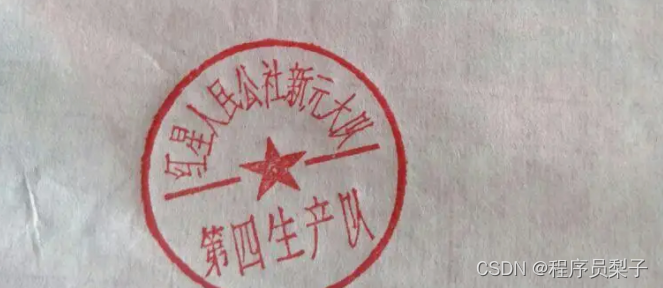前言
🚀 作者 :“程序员梨子”
🚀 **文章简介 **:本篇文章主要是写了opencv的提取印章文字小程序!
🚀 **文章源码免费获取 : 为了感谢每一个关注我的小可爱💓每篇文章的项目源码都是无
偿分享滴💓👇👇👇👇
点这里蓝色这行字体自取,需要什么源码记得说标题名字哈!私信我也可!
🚀 欢迎小伙伴们 点赞👍、收藏⭐、留言💬
正文

这期分享的是使用opencv提取印章,很多时候我们需要电子版的章,所以今天就带大家使用代码
提取出来!
Photoshop虽然强大,但是奈何小编不会使啊,昨天就有一个小伙伴问我能不能帮忙,这不?PS虽
然我不会,但是我会写代码呀!这可难不倒我!安排安排~
(特别提醒:所有爱好设计和喜欢做图的小伙伴们,切记千万不要帮着老板或者朋友PS伪造公
章,刑法第280条特别指出,伪造证件印章,是可以追究刑事责任的,违法的事情不要做哦。)
教程送👇,源码就文末或者前文的蓝色字体自己免费拿哈——来咯!

1)效果展示
原图——

效果图——

2)源码展示
import cv2
import numpy as np
class Seal:
def __init__(self, img_path):
"""
初始化图片
:param img_path: 原始图片路径 """
self.image = cv2.imread(img_path)
self.img_shape = self.image.shape
self.file_name = img_path.split('.')[0].split('\\')[-1]
def unify_img_size(self):
"""
统一图片的大小
:return:返回一张未处理的目标图片 """
img_w = 650 if self.img_shape[1] > 600 else 400
self.image = cv2.resize(self.image, (img_w, int(img_w * self.img_shape[0] / self.img_shape[1])), interpolation=cv2.IMREAD_COLOR)
impng = cv2.cvtColor(self.image.copy(), cv2.COLOR_RGB2RGBA)
return impng
def img_binaryzation(self,hue_image, low_range, high_range, imgpng):
th = cv2.inRange(hue_image, low_range, high_range)
element = cv2.getStructuringElement(cv2.MORPH_RECT, (1, 1))
th = cv2.dilate(th, element)
index1 = th == 255
print_img = np.zeros(imgpng.shape, np.uint8)
print_img[:, :, :] = (255, 255, 255, 0)
print_img[index1] = imgpng[index1] # (0,0,255)
return print_img
def img_enhance(self):
imgpng = self.unify_img_size()
hue_image = cv2.cvtColor(self.image, cv2.COLOR_BGR2HSV) # 处理图像色调
low_range = np.array([130, 43, 46]) # 设下边界
high_range = np.array([180, 255, 255]) # 设上边界
print1 = self.img_binaryzation(hue_image, low_range, high_range, imgpng)
low_range = np.array([0, 43, 46])
high_range = np.array([9, 255, 255])
print2 = self.img_binaryzation(hue_image, low_range, high_range, imgpng)
imgreal = cv2.add(print2, print1)
white_px = np.asarray([255, 255, 255, 255])
(row, col, _) = imgreal.shape
for r in range(row):
for c in range(col):
px = imgreal[r][c]
if all(px == white_px):
imgreal[r][c] = imgpng[r][c]
return imgreal
def extension_img(self):
"""
边缘检测,截取并输出结果
:return:
"""
imgreal = self.img_enhance()
# 扩充图片防止截取部分
print4 = cv2.copyMakeBorder(imgreal, 50, 50, 50, 50, cv2.BORDER_CONSTANT, value=[255, 255, 255, 0])
print2gray = cv2.cvtColor(print4, cv2.COLOR_RGBA2GRAY)
_, grayfirst = cv2.threshold(print2gray, 254, 255, cv2.THRESH_BINARY_INV)
element = cv2.getStructuringElement(cv2.MORPH_RECT, (22, 22))
img6 = cv2.dilate(grayfirst, element)
c_canny_img = cv2.Canny(img6, 10, 10)
contours, hierarchy = cv2.findContours(c_canny_img, cv2.RETR_EXTERNAL, cv2.CHAIN_APPROX_NONE)
areas = []
for i, cnt in enumerate(contours):
x, y, w, h = cv2.boundingRect(cnt)
area = w * h
ars = [area, i]
areas.append(ars)
areas = sorted(areas, reverse=True)
maxares = areas[:1]
x, y, w, h = cv2.boundingRect(contours[maxares[0][1]])
print5 = print4[y:(y + h), x:(x + w)]
# 高小于宽
if print5.shape[0] < print5.shape[1]:
zh = int((print5.shape[1] - print5.shape[0]) / 2)
print5 = cv2.copyMakeBorder(print5, zh, zh, 0, 0, cv2.BORDER_CONSTANT, value=[255, 255, 255, 0])
else:
zh = int((print5.shape[0] - print5.shape[1]) / 2)
print5 = cv2.copyMakeBorder(print5, 0, 0, zh, zh, cv2.BORDER_CONSTANT, value=[255, 255, 255, 0])
resultprint = cv2.resize(print5, (150, 150))
cv2.imwrite(r'output\{}_result.png'.format(self.file_name), resultprint)
if __name__ == '__main__':
s = Seal(r"src\2.jpg")
s.extension_img()
总结
效果很不错滴,感兴趣的朋友可以试试啦~
关注小编获取更多精彩内容!记得点击传送门哈👇
记得三连哦! 如需打包好的源码+素材免费分享滴!!传送门****

版权归原作者 程序员梨子 所有, 如有侵权,请联系我们删除。
